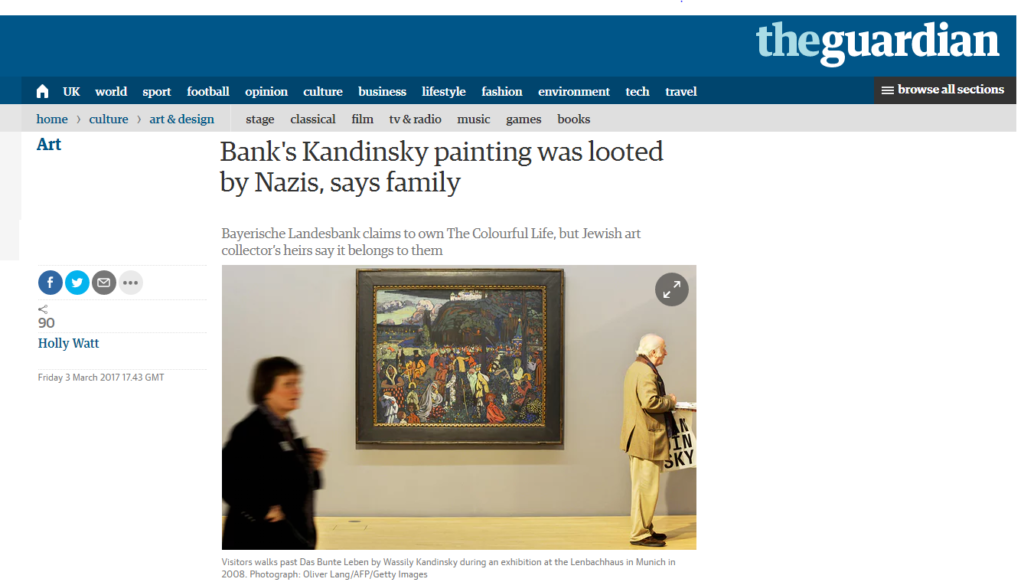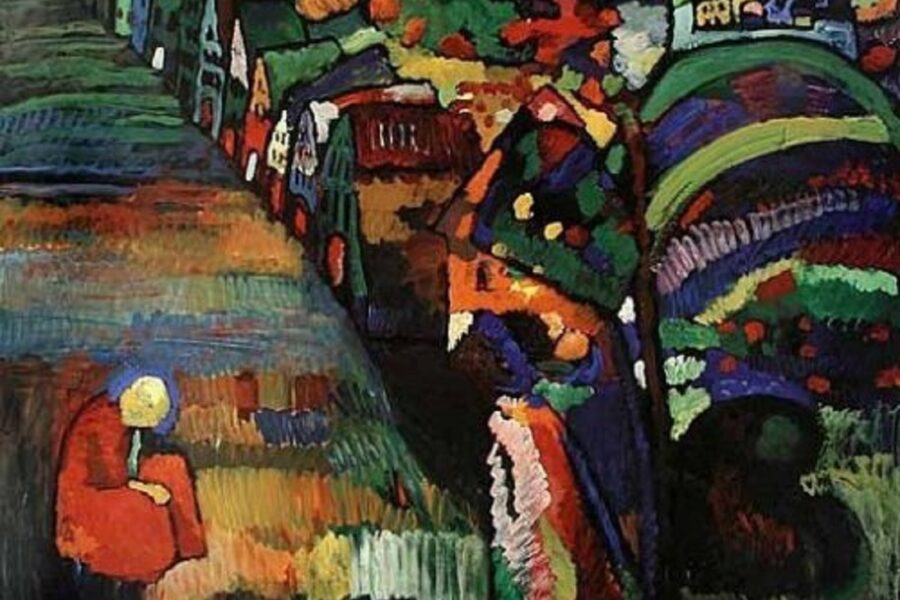
A painting by Russian artist Wassily Kandinsky has become the subject of a legal battle over claims that it was looted by the Nazis during the second world war.
The Colourful Life or Das Bunte Leben, which has been described as one of the artist’s most important works, hangs in a gallery in Germany, but the heirs of a Jewish art collector, Emanuel Lewenstein, now claim that it was sold without the permission of the family in a controversial auction in 1940.
They filed a claim on Friday morning in New York against a German bank which believes it owns the painting. According to the filing, the painting has an estimated value of £65m ($80m).
James Palmer from Mondex, a Canadian company that works with families to reclaim looted art, said that he hoped that the Lewenstein family would be able to prove their ownership.
“We hope that the Bayerische Landesbank, which is owned and managed by the government of Bavaria, will reconsider its position and that it will return this stolen painting back to the Lewenstein family from whom it was despoiled. Nothing can undo the traumatic events suffered by the Lewensteins, however the dignified return of their property is the least that any decent, conscientious organisation should be pleased to do.”
Dutch art collector Lewenstein bought The Colourful Life after it was painted in 1907. Following Lewenstein’s death, his widow loaned it to the Stedelijk Museum in Amsterdam for safekeeping.
When she died shortly before the war, the painting passed to her two children, Robert and Wilhelmine. Wilhelmine left the Netherlands for Mozambique in 1938, and Robert fled to New York in 1939 fearing persecution from the Nazis.
In 1940, the painting was sent to one of the best-known auction houses in Amsterdam at the time, where dozens of looted works were sold. The Lewensteins claim it was sold without the family’s permission and at a heavily discounted price, which was due to questions over its ownership, after the Nazis invaded Holland.
The October 1940 catalogue from the Frederik Muller & Co auction house lists dozens of lots. The sale included several paintings from a famous collection previously owned by Jacques Goudstikker, one of the best-known Jewish art dealers in Amsterdam.
The Kandinsky is listed as lot 204, and was apparently sold for 250 Dutch Guilders, a price representing only 10-20% of its then market value. According to the court documents, no one from the Lewenstein family ever received any proceeds from the sale.
The heirs claim that at the time, it was impossible that a Jewish art dealer would have “called attention to themselves or their ownership of a substantial art collection by putting it up for sale at a public auction house, much less at a sale together with the vaunted Goudstikker Collection.”
The painting was bought by BayernLB in 1972. and is currently on loan to the Lenbachhaus gallery in Munich.
Last year, a painting by Kandinsky was sold for a record price of £18.5m ($23.2m), so it could represent a huge windfall for the heirs if they can prove it was looted.
Francesca Davis, Robert Lewenstein’s daughter, is one of the possible heirs. She was recently sent a photograph of the painting, and said she was amazed by it.
Davis, who lives in Texas and works in marketing, said that the painting was important to her relatives: “I feel that my family lost everything during the war. We lost relatives. As far as my parents were concerned, they lost everything except the shirts on their backs.”
Davis grew up hearing stories about her family’s escape from Europe and the Nazis. She said that she thought Kandinsky was an “unbelievable genius”.
Davis said: “I saw it for the first time recently, and I was amazed by it. It’s a treasure that belongs to the world.”
Daniella Luxembourg, an art dealer and expert, said that Das Bunte Leben was a “seminal piece”.
“This is an iconic piece, and it belongs in a public museum. The size of it makes it really extraordinary. He painted this at a key point in his life, just before he moved to pure abstract works. It is one of his most important works.”
There are jurisdictional issues around where the future of the Kandinsky will be decided. The case will either be resolved in the New York court system or through the German Limbach Commission, which advises on the return of cultural property.
Museums usually follow the “Washington Principles” for handing over looted art. However, the bank is understood to believe that that the artwork is on a long-term loan to the museum, and the financial institution is not covered by the Washington Principles.
In a statement, the bank said: “In 1972, BayernLB legally acquired the painting “Das Bunte Leben” by Kandinsky at the instigation of the City of Munich. The purchase negotiations were handled by the Lenbachhaus museum, where the painting has been publicly displayed on permanent loan ever since. Nonetheless, BayernLB is willing to take part in a review by the so-called Limbach Commission. BayernLB feels, however, that the commission’s decision should be binding on all parties. BayernLB has expressed its desire that the painting remain on public display at the Lenbachhaus rather than be taken away.”


